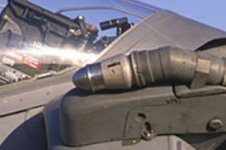It is a "fixed" refueling probe. Both single and two-seaters were fitted with them, though not all of them, and not necessarily during production. Air refueling was in its infancy as the Cougar came into being, and the tankers were initially AJ "Savage"s. The development of the 300 gal Sargent Fletcher "buddy store" that could be carried by the A-4 and other tactical jets was a huge step forward.
As the Cougar gracefully aged and transitioned to the Reserves, Training Command and utility use, many probes were removed to reduce maintenance requirements.
The tip of the probe in all Navy planes was common - the same fixture, even though some probes are/were fixed like the A-4, A-6, A-3 etc, and some articulated, foldable retracting type, the tip is the same so that it mates with a common refueling hose receptacle in the "basket".
here is the tip on the stowable probe of a "Harrier" - they are the same on all USN/USMC airplanes:
The very tip has a hole for fuel to enter. The hole is opened (by a valve assembly)when the collar at the base of the tip is pushed back against spring pressure by the female ring of the refueling hose basket. When a plane pulls out of the basket, the collar springs forward, closing the hole via valve action.
The circular assembly behind the collar serves to act as a locking device - once the probe is firmly seated in the basket, that assembly allows some airplane motion relative to the tanker without falling out of the basket. The locking is fairly solid, but too much tension, such as purposely backing out after refueling, will cause separation. There is almost always a little fuel spray when disengaging as the collar does not close the hole in the tip instantaneously.
I have to surmise today's F/A-18s have not change a bit - the initial ones were the same for sure. I know the Navy has a newer buddy store these days but I imagine that the basics have not changed.
Hope this is of some help to Rob.







